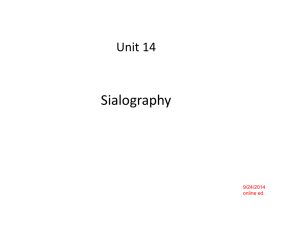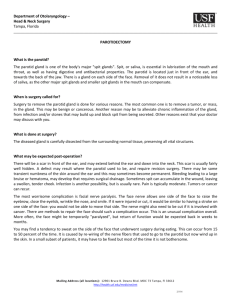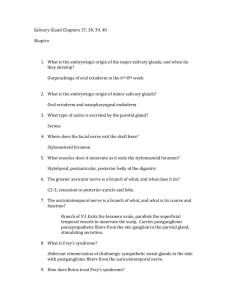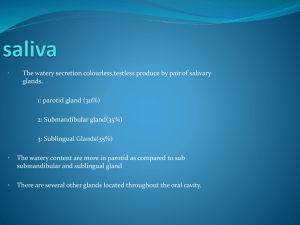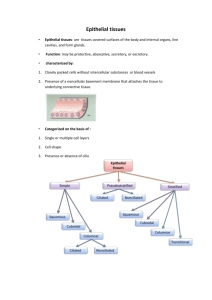Salivary Glands
advertisement
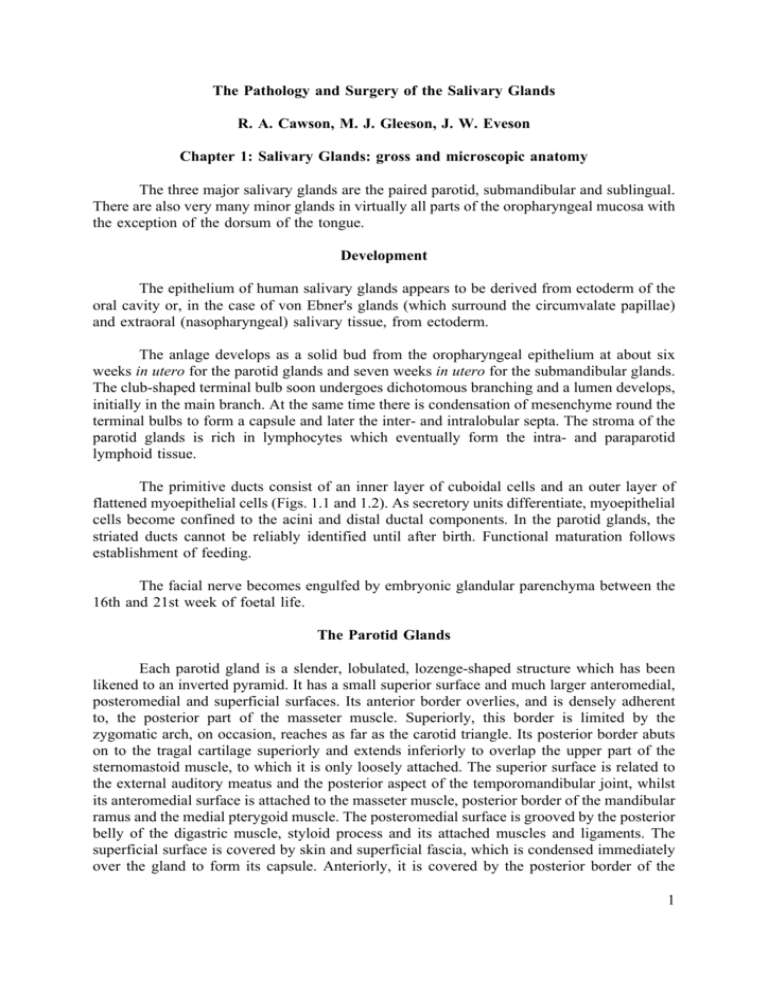
The Pathology and Surgery of the Salivary Glands R. A. Cawson, M. J. Gleeson, J. W. Eveson Chapter 1: Salivary Glands: gross and microscopic anatomy The three major salivary glands are the paired parotid, submandibular and sublingual. There are also very many minor glands in virtually all parts of the oropharyngeal mucosa with the exception of the dorsum of the tongue. Development The epithelium of human salivary glands appears to be derived from ectoderm of the oral cavity or, in the case of von Ebner's glands (which surround the circumvalate papillae) and extraoral (nasopharyngeal) salivary tissue, from ectoderm. The anlage develops as a solid bud from the oropharyngeal epithelium at about six weeks in utero for the parotid glands and seven weeks in utero for the submandibular glands. The club-shaped terminal bulb soon undergoes dichotomous branching and a lumen develops, initially in the main branch. At the same time there is condensation of mesenchyme round the terminal bulbs to form a capsule and later the inter- and intralobular septa. The stroma of the parotid glands is rich in lymphocytes which eventually form the intra- and paraparotid lymphoid tissue. The primitive ducts consist of an inner layer of cuboidal cells and an outer layer of flattened myoepithelial cells (Figs. 1.1 and 1.2). As secretory units differentiate, myoepithelial cells become confined to the acini and distal ductal components. In the parotid glands, the striated ducts cannot be reliably identified until after birth. Functional maturation follows establishment of feeding. The facial nerve becomes engulfed by embryonic glandular parenchyma between the 16th and 21st week of foetal life. The Parotid Glands Each parotid gland is a slender, lobulated, lozenge-shaped structure which has been likened to an inverted pyramid. It has a small superior surface and much larger anteromedial, posteromedial and superficial surfaces. Its anterior border overlies, and is densely adherent to, the posterior part of the masseter muscle. Superiorly, this border is limited by the zygomatic arch, on occasion, reaches as far as the carotid triangle. Its posterior border abuts on to the tragal cartilage superiorly and extends inferiorly to overlap the upper part of the sternomastoid muscle, to which it is only loosely attached. The superior surface is related to the external auditory meatus and the posterior aspect of the temporomandibular joint, whilst its anteromedial surface is attached to the masseter muscle, posterior border of the mandibular ramus and the medial pterygoid muscle. The posteromedial surface is grooved by the posterior belly of the digastric muscle, styloid process and its attached muscles and ligaments. The superficial surface is covered by skin and superficial fascia, which is condensed immediately over the gland to form its capsule. Anteriorly, it is covered by the posterior border of the 1 platysma muscle. Within the capsule are the superficial parotid lymph nodes and the greater auricular nerve, which is derived from the cervical plexus and provides sensory innervation to the lower two-thirds of the pinna. Several structures run through the gland and are of considerable surgical importance. The most notable of these is the facial nerve (see below). The external carotid artery enters the posteromedial surface of the gland before dividing into the maxillary artery and the superficial temporal artery. The latter gives off the transverse facial artery before emerging from the superior surface whilst the maxillary artery leaves the gland from its anteromedial surface. The retromandibular vein is formed in the gland by the union of the maxillary and superficial temporal veins and leaves its inferior extremity to join the posterior auricular vein and become the external jugular vein. However, the retromandibular vein divides within the gland and its anterior division courses forwards to emerge from the anterior border of the gland as the posterior facial vein. These veins are exceptionally easy to image with ultrasound. They lie immediately deep to the plane of the facial nerve but are of little value in locating the latter. Within the parotid, the tree-like tributary ducts join near the anterior border of the gland and leave it to pass forward over the superficial surface of the masseter along an imaginary line drawn from the angle of the mouth to the attachment of the earlobe. The duct, Stenson's duct, passes through the buccinator muscle to open into the mouth at the parotid papilla. Small accessory glands may lie along the lnie of the parotid duct. The facial nerve The branching patterns of the facial nerve are exceedingly complex and hence have been inadequately or inaccurately described in classical anatomical texts. The location and variations of these branches are of immense significance and this fine detail has been derived mainly from surgical research. These details and the anatomical relations of the main trunk of the facial nerve at the stylomastoid foramen are therefore discussed in Chapter 9, in relation to the surgery of the parotid gland. The deep and superficial lobes Much has been written about the superficial and deep lobes of the parotid gland and whether there is an isthmus between them. At first sight, this would appear to be an academic exercise, as it is common surgical knowledge that there is always parotid tissue medial to the facial nerve. The reasons for this controversy are twofold. First, there has been a desire to establish why development of a surgical plane round the facial nerve within the parotid gland is relatively simple. Second, it seems likely that the presence and site of an isthmus determines the origin and management of deep lobe tumours, as discussed in relation to surgery of parotid gland tumours. 2 The autonomic nerve supply The secretomotor fibres to the parotid gland emerge from the otic ganglion which is closely related to the auriculotemporal nerve. Preganglionic fibres reach the ganglion from the inferior salivary nucleus via the glossopharyngeal nerve, tympanic plexus and lesser petrosal nerve. The sympathetic supply reaches the gland from the superior cervical ganglion via the neural plexus surrounding the major blood vessels. The effects of sympathetic and parasympathetic impulses and of drugs acting on these autonomic pathways are discussed in more detail in Chapter 5. The parotid lymphoid tissue There are periparotid nodes, while within the glands there are also many nodes and small, less well organized aggregates of lymphoid tissue. McKean et al (1985) carried out an autopsy study mainly on elderly persons, on the distribution of these nodes. Using strict anatomical criteria for defining the nodes and excluding small lymphoid aggregates, they found 193 intraparotid nodes in ten cadavers. Virtually all of these nodes were superficial to the facial nerve and only 16 nodes were in the deep lobe. Most of the latter were superficial to the retromandibular vein. The Submandibular Glands The submandibular salivary glands consist of a large superficial and a smaller deep lobe which are continuous around the posterior border of the mylohyoid muscle. The medial aspect of the superficial part lies on the inferior surface of the mylohyoid muscle; the lateral surface is covered by the body of the mandible while its inferior surface rests on both bellies of the digastric muscle. Its inferior surface is covered by the platysma muscle, deep fascia and skin. The anterior facial vein runs over the surface of the gland within this fascia and is joined superiorly by the facial artery, which is for the most part related to the deep surface of the gland. Posteriorly, the submandibular and parotid glands are separated by a condensation of deep cervical fascia - the stylohyoid ligament. The deep part of the gland lies on the hyoglossus muscle where it is related superiorly to the lingual nerve and inferiorly to the hypoglossal nerve and lingual vein. The capsule of the gland is well defined and derived from the deep cervical fascia which splits from the greater cornu of the hyoid bone to enclose it. The submandibular duct (Wharton's duct) is formed by the union of several tributaries and is about 5 cm in length. It emerges from the middle of its deep surface and runs in the space between the hyoglossus and mylohyoid muscles to the anterior part of the floor of the mouth, where it opens onto a papilla to the side of the lingual frenulum. In its anterior part, it is related laterally to the sublingual glands and may receive many of their ducts. During its course on the hyoglossus muscle, it is crossed from its lateral side by the lingual nerve. The submandibular gland receives its blood supply from branches of the facial and 3 lingual arteries. Venous drainage accompanies these vessels. There are several lymph nodes immediately adjacent to the superficial part of the gland; these drain the latter as well as adjacent structures. The autonomic nerve supply The parasympathetic supply to the submandibular gland is from the superior salivary nucleus via the nervus intermedius, facial nerve, chorda tympani, lingual nerve and submandibular ganglion. Multiple parasympathetic secretomotor fibres are distributed from the submandibular ganglion which hands from the lingual nerve. The sympathetic nerve supply is derived from the superior cervical ganglion via the plexus on the walls of the facial and lingual arteries. The Sublingual Glands The sublingual salivary glands lie in the anterior part of the floor of the mouth, between the mucous membrane, the mylohyoid muscle and the body of the mandible close to the symphysis, where each may produce a small depression - the sublingual fossa. Each gland has numerous excretory ducts which either open directly onto the mucous membrane or into the terminal part of the submandibular duct. The Minor Glands Innumerable minor salivary glands are widely distributed in the lateral margins of the tongue, the lips and buccal mucosa, palate, glossopharyngeal area, and retromolar pad. Overall, they contribute about 10% of the saliva. Palatal glands are the sites of predilection for minor gland neoplasms. Microscopic Anatomy The parenchyma of each major gland is enclosed by a fibrous capsule which also contains some elastic tissue as well as blood vessels, autonomic nerve fibres and IgAsecreting plasma cells. The capsule is well defined in the parotid and submandibular glands, but less well developed in the sublingual and minor glands. The glands are split into lobules of variable size by fibrous septa. The parenchyma consists of varying proportions of serous and mucous cells and ducts (Figs. 1.3 and 1.4). The serous acini consist of wedge-shaped secretory cells with basal nuclei surrounding a lumen which forms the origin of an intercalated duct. The cytoplasm of the serous cells is densely packed with heavily basophilic secretory granules ready to discharge their contents, predominantly amylase. At the ultrastructural level, these cells contain densely packed endoplasmic reticulum in addition to the secretory granules and other cytoplasmic organelles (Fig. 1.5). The mucous acinar cells have almost clear cytoplasm, consisting of vacuoles 4 containing sialomucins, and have flattened basal nuclei. Ultrastructurally, the mucous cells contain relatively little endoplasmic reticulum. In the case of the mixed glands and in particular the submandibular gland, the mucous cells have caps (demilunes) of basophilic, granular serous cells. The parotid glands are almost exclusively serous (Figs 1.6 and 1.7), while the submandibular glands are mixed (Fig. 1.8), although the serous component predominates and the mucous component is both variable and sometimes minimal. The sublingual gland is predominantly mucous whilst the minor glands if the tongue, lips and buccal mucosa are seromucinous. The minor glands of the palate, glossopharyngeal area, retromolar pad and lateral borders of the tongue tend to be predominantly mucous (Figs 1.9 and 1.10). Fat is a conspicuous component of the parotid glands and tends to increase in amount with age (Fig. 1.6). Myoepithelial cells lie between the basal lamina of the acinar cells and the basal membrane of the acinus (Figs 1.11 and 1.12). Myoepithelial cells vary in their morphology and cannot be reliably identified by light microscopy. When their recognition is important in tumour diagnosis, reliance if frequently placed on immunocytochemistry to confirm that they are strongly S-100 protein and myosin positive but have variable keratin reactions. More recently, it has been shown that S-100 protein has three forms and staining patterns vary according to whether monoclonal or polyclonal antibodies are used and which of the S-100 variants are used. Though many believe that S-100beta is localized to myoepithelial cells and that the alpha-variant frequently stains duct or acinar cells, conflicting findings have been reported by other workers. In particular, Dardick et al (1991), in a careful study of normal salivary glands, have found that normal myoepithelial cells were S-100 negative, but strongly positive for cytokeratin 14 and smooth muscle-specific protein. Only the associated nerve fibres stained to a variable degree for S-100 protein and more reliably, for neurone-specific enolase. These workers showed by electron microscopy that nerve fibres were external to the basal lamina of acini and their surrounding myoepithelial processes but the gap between them was sometimes as little as 300 nm. They therefore concluded that S-100 staining of the network of unmyelinated nerve fibres closely associated with the normal myoepithelium of salivary glands has been misinterpreted as positive staining of myoepithelial cells. By contrast, neoplastic myoepithelial cells may acquire the ability to stain positively for S-100 protein, but their variability in staining and misinterpretation of the immunohistochemical findings in the past, means that the role of these cells in the histogenesis of certain tumors may perhaps have to be reassessed. Ultrastructurally, the cytoplasm of myoepithelial cells contains microfilaments of actomyosin, which run parallel to the outer surface (Fig. 1.13), glycogen granules and lipofuscin. Pinocytic vesicles, indicative of active transport of materials between the intra- and extracellular spaces, are also present. The duct system The intercalated ducts are short. They are lined by a single layer of cuboidal epithelium with relatively large, central nuclei and are surrounded by myoepithelial cells (Fig. 5 1.14). The intercalated duct cells contain few organelles but actively secrete fluid. The intercalated ducts are continuous with the striated ducts (Figs. 1.7 and 1.8) which have a brush border (microvilli) on their luminal face and parallel finger-like cytoplasmic extensions from the opposite pole. Ultrastructurally, the parallel infolding of the basal lamina is conspicuous as are the many mitochondria (Fig. 1.15). These cells actively secrete bicarbonate, regulate the water content of saliva and can secrete trace elements and iodine. The duct system also actively secretes or reabsorbs sodium, potassium, chloride and other ions. The striated ducts run into the interlobular duct system which has a simple transport function. Mucous cells are an occasional finding in striated ducts (Fig. 1.16). Sebaceous tissue Groups of sebaceous glands are scattered throughout the parotid gland parenchyma and can be seen if sufficient tissue is examined (Fig. 1.17). If a section is cut in the appropriate plane, the sebaceous tissue can be seen to be arising from small ducts. Saliva The mucosa-associated lymphoid tissue (MALT) The mucosa-associated lymphoid tissue is part of the much larger gut-associated lymphoid tissue (GALT) and like the latter secretes IgA. This salivary mucosa-associated lymphoid tissue can give rise to primary MALT lymphomas especially in lymphoepithelial lesions. Secretory IgA consists of a dimer joined by a secretory piece protein formed by the epithelial cells of the duct system. The relative amounts of IgA secreted by the different salivary glands varies widely. Its apparent function is to form a barrier to the adhesion of bacteria to the oral tissues. However, the mouth teems with bacteria, and dental caries and gingivitis typically progress unchecked unless controlled by artificial preventive measures. IgA deficiency is also one of the most common immunodeficiency disorders, affecting approximately 1 in 600 of the general population, but there is no evidence that deficiency leads to greater susceptibility to oral infections. In some cases at least, IgA deficiency may be compensated by IgG or IgM secretion in significant amounts in the saliva but there appears to be little evidence of any contribution of this change to the prevention of oral infections. This lymphoid tissue is present in the capsule of the parotid glands and within the substance of these glands. Within the gland, the lymphoid tissue usually has a well-defined capsule and a peripheral sinus, but at the hilum the lymphoid tissue often merges with the gland parenchyma. Conversely, salivary gland tissue can often be found in intra- and paraparotid lymph nodes and also in lymph nodes in the upper cervical chain. In children, it is not uncommon to find both ductal and acinar tissue in this lymphoid tissue but in adults, only ducts are usually found (Fig. 1.18). Many believe that Warthin's tumours and lymphoepithelial cysts originate in this ectopic salivary tissue. 6 Other antibacterial components of saliva The function of substances such as lysozyme and lactoferrin secreted by the salivary epithelium and which have antibacterial activity in vitro is unclear. From the clinical viewpoint therefore, the main contribution of saliva to defence against infection appears to be the largely mechanical effect of its flow, washing down microbes into the gastric acid. Digestive enzymes in saliva Amylase is the main digestive enzyme secreted in the saliva and it can break down polysaccharides such as starch into sugars. This process is assisted by the comminution and mixing of saliva with food by mastication. Nevertheless, food is normally so briefly in the mouth that this component of digestion is only initiated before swallowing, but later completed in the small intestine by pancreatic amylase. In acute inflammatory disease of the major salivary glands, particularly mumps, serum levels of the salivary isoenzyme, S-amylase, are raised but estimation of serum S-amylase levels is of no more than theoretical value in the diagnosis of mumps (Chapter 4). S-amylase is also produced by a variety of tissues with the result that serum S-amylase levels are also raised in diverse conditions such as acute alcohol intoxication, diabetic ketoacidosis and the postoperative state. By contrast, estimation of P-amylase is of value in the early diagnosis of acute pancreatitis and its level is raised within the first day after the onset of symptoms. Notes 1. V. von Ebner (1842-1925), Austrian histologist. 2. Niels Stenson (1638-1686) gives a particularly strong aura of respectability to salivary gland studies in that he was beatified by Pope John Paul II in 1988. He is now the Blessed Niels Stenson and thereby on the first step leading to canonization and sainthood. Stenson (or Stensen), a Dane, discovered the parotid duct at the age of 22, described other glands in the mouth and gastrointestinal tract, and made several other contributions to anatomy. Contrary to general belief at that time, Stenson maintained that tears had a lubricant function and were formed in the lacrimal glands. Ultimately, Stenson was appointed Apostolic Vicar of the North and gave up his scientific studies. He devoted himself to pastoral duties, living in poverty as an ascetic, and died at the age of 48. 3. T. Wharton (1614-1673), physician to St Thomas's Hospital London, described the submandibular duct in 1656. 7
